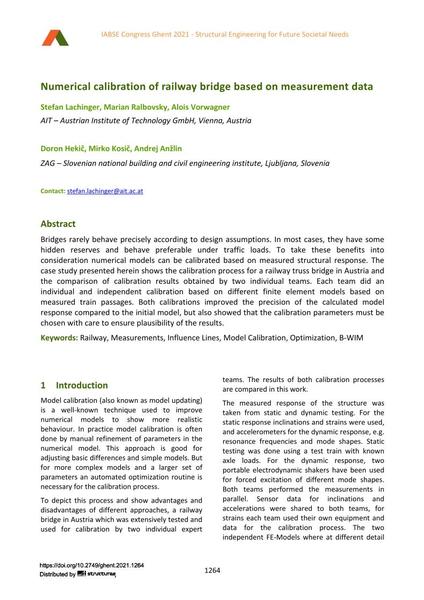Numerical calibration of railway bridge based on measurement data

|
|
|||||||||||
Détails bibliographiques
| Auteur(s): |
Stefan Lachinger
(AIT – Austrian Institute of Technology GmbH, Vienna, Austria)
Marian Ralbovsky (AIT – Austrian Institute of Technology GmbH, Vienna, Austria) Alois Vorwagner (AIT – Austrian Institute of Technology GmbH, Vienna, Austria) Doron Hekič (ZAG – Slovenian national building and civil engineering institute, Ljubljana, Slovenia) Mirko Kosič (ZAG – Slovenian national building and civil engineering institute, Ljubljana, Slovenia) Andrej Anžlin (ZAG – Slovenian national building and civil engineering institute, Ljubljana, Slovenia) |
||||
|---|---|---|---|---|---|
| Médium: | papier de conférence | ||||
| Langue(s): | anglais | ||||
| Conférence: | IABSE Congress: Structural Engineering for Future Societal Needs, Ghent, Belgium, 22-24 September 2021 | ||||
| Publié dans: | IABSE Congress Ghent 2021 | ||||
|
|||||
| Page(s): | 1264-1272 | ||||
| Nombre total de pages (du PDF): | 9 | ||||
| DOI: | 10.2749/ghent.2021.1264 | ||||
| Abstrait: |
Bridges rarely behave precisely according to design assumptions. In most cases, they have some hidden reserves and behave preferable under traffic loads. To take these benefits into consideration numerical models can be calibrated based on measured structural response. The case study presented herein shows the calibration process for a railway truss bridge in Austria and the comparison of calibration results obtained by two individual teams. Each team did an individual and independent calibration based on different finite element models based on measured train passages. Both calibrations improved the precision of the calculated model response compared to the initial model, but also showed that the calibration parameters must be chosen with care to ensure plausibility of the results. |
||||
| Copyright: | © 2021 International Association for Bridge and Structural Engineering (IABSE) | ||||
| License: | Cette oeuvre ne peut être utilisée sans la permission de l'auteur ou détenteur des droits. |
||||
